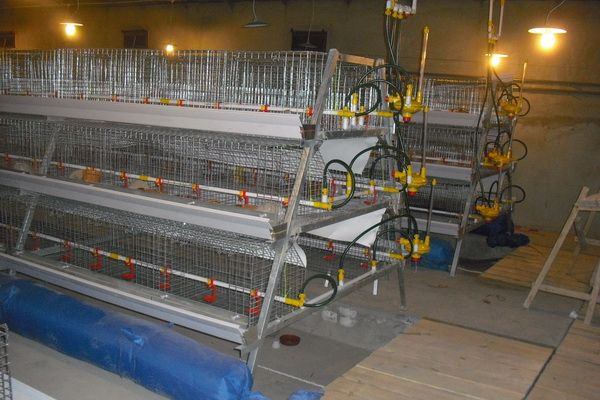Chicken Equipment - Feeding and drinking of chickens
1,Drinking water
After the chicks hatch, the water disperses quickly and must be fed as soon as possible. At the same time, drinking water can also clear the gastrointestinal tract, excrete meconium, promote metabolism, and accelerate the absorption of yolk.
The principle of drinking water for chicks is: suitable time, adequate water level, timely training, clean water, and free drinking water. Usually the chicks are transported to the brooding house for a short break to drink, because the hatching time is 24 hours. With long-distance transportation, the chicks are very expensive and should drink water as soon as possible. The first week of brooding requires drinking warm boiled water. The water temperature is close to room temperature and maintains around 20c. On the first day of drinking, 5% glucose or sucrose should be added. If the chick is dehydrated severely, drink 3 days of syrup. In addition, in order to reduce stress, a multidimensional electrolyte is added to the water of the first week, and clean cold water can be drunk after 1 week. The brooder house should have enough water dispensers and be placed evenly. Each chicken should have a water level of at least 2.5 cm. The height of the drinking fountain should be appropriate. The height of the water tray and chicken back should be appropriate. The height of the water tray should be adjusted as the chicken grows. . It can be lifted with wooden blocks or bricks. It can also be lifted high. Prevent the chicken feet from entering the trays to contaminate the water or wet the litter and lint or even drown. For young chicks who do not drink water when they arrive at the brooding house, artificial adjustments should be made. That is, the head of the chicken is held by hand, and the mouth of the chicken is inserted into the water dish to force the drink L ~ 2 times so that the chick can know the water afterwards. If you use a nipple drinker, initially add some hanging cups to attract chickens to drink. Broiler drinking water should be kept clean and in line with livestock and poultry drinking water standards. The amount of drinking water must be sufficient. Always keep water, be free to drink at any time, and never stop drinking water to prevent chicks from robbing and causing some chicks to fall into the water and drown. Especially in hot seasons, you should maintain adequate drinking water. The amount of drinking water varies with the amount of feed and temperature, which is usually 2 to 3 times the feed intake, and the higher the temperature, the greater the amount of drinking water.
2, chicken feeding
Open time: Open food means that the chicks eat for the first time. Generally, the chicks can eat immediately after drinking water, which is beneficial for the chicks to gain weight. The food must not be eaten too late, otherwise the chicks will consume too much physical energy, which will easily lead to weakness and dehydration, affect the growth and development, and reduce the survival rate.
Feeding method: The initial feeding mainly trains chickens to eat. The feed can be evenly sprinkled in the feed tray or plastic sheeting, kraft paper, allowing chicks to feed freely. For chicks who do not know how to eat, they should be surrounded many times in places where there is feed, so that they can learn to eat. Starting on the first day, the feed intake of chicks is generally not too much. Each chick will eat an average of 4 to 5 grams. The amount of feed consumed on the second day will increase exponentially. If it is found that the food pan is empty, it will be added. Generally, it will be given every 2 hours. Feed 1 times to ensure adequate feed, allow them to feed freely, increase feed intake, and promote growth and development. In order to prevent wasting feed, so as not to increase feed costs. Feeding of broilers should be done regularly and quantified. According to the different stages of growth and development of chickens, the maximum daily feed intake can be divided into several feedings. Feeding of feedstuffs should not be carried out or feeding times should be too small. Usually 1 to 3 days, 1 feeding every 2 hours, 1 feeding at night, 3 to 8 days after each day and night, 3 times a day later. Pay attention to the material level and water level when feeding in batches. For every 100 chicks in the first week, use an open dish, a 4 kg drinking fountain, and after each week, 2 round buckets per 100 chickens, 2 Prasong drinker. In addition, the bucket and the waterer should be evenly distributed, and the distance should be closer, so that the chickens can drink water immediately after eating the ingredients. In addition, the buckets and buckets should be fixed to prevent chickens from overturning and causing waste. Watering can make chicken droppings. Wet, pollute the environment. The feeding speed is faster, allowing the chicken to eat evenly at the same time.
Feed selection: The digestive organs of primary chicks are not yet well-developed, and the gastrointestinal volume is relatively small. Feeding for food requires nutritious, easily digestible, palatable, and easy to feed ingredients. The feed pellets should be of appropriate thickness and shape, similar in size to millet, and can optionally be eaten by using granular broken materials. Millet or corn flour can also be used as a starting material. Later, with the increase of age, according to different growth and development stages, the materials in different periods are replaced to meet their growth and development needs. Replacement of feed should be gradually replaced, so that the chicken has a process of adaptation, so as to avoid sudden changes in diet caused by indigestion, affecting growth and development.
Feeder adjustment: The feeder is adjusted according to the age of the chicks. The chicks use the food dish in the first week and the barrels in the second week. The feeding utensils should be sufficient and the height is equal to that of the chicken back. It is necessary to adjust the height of the feeder as the body height of the chicken grows. This will not only facilitate feeding and reduce feed wastage, but also prevent feed pollution.
























